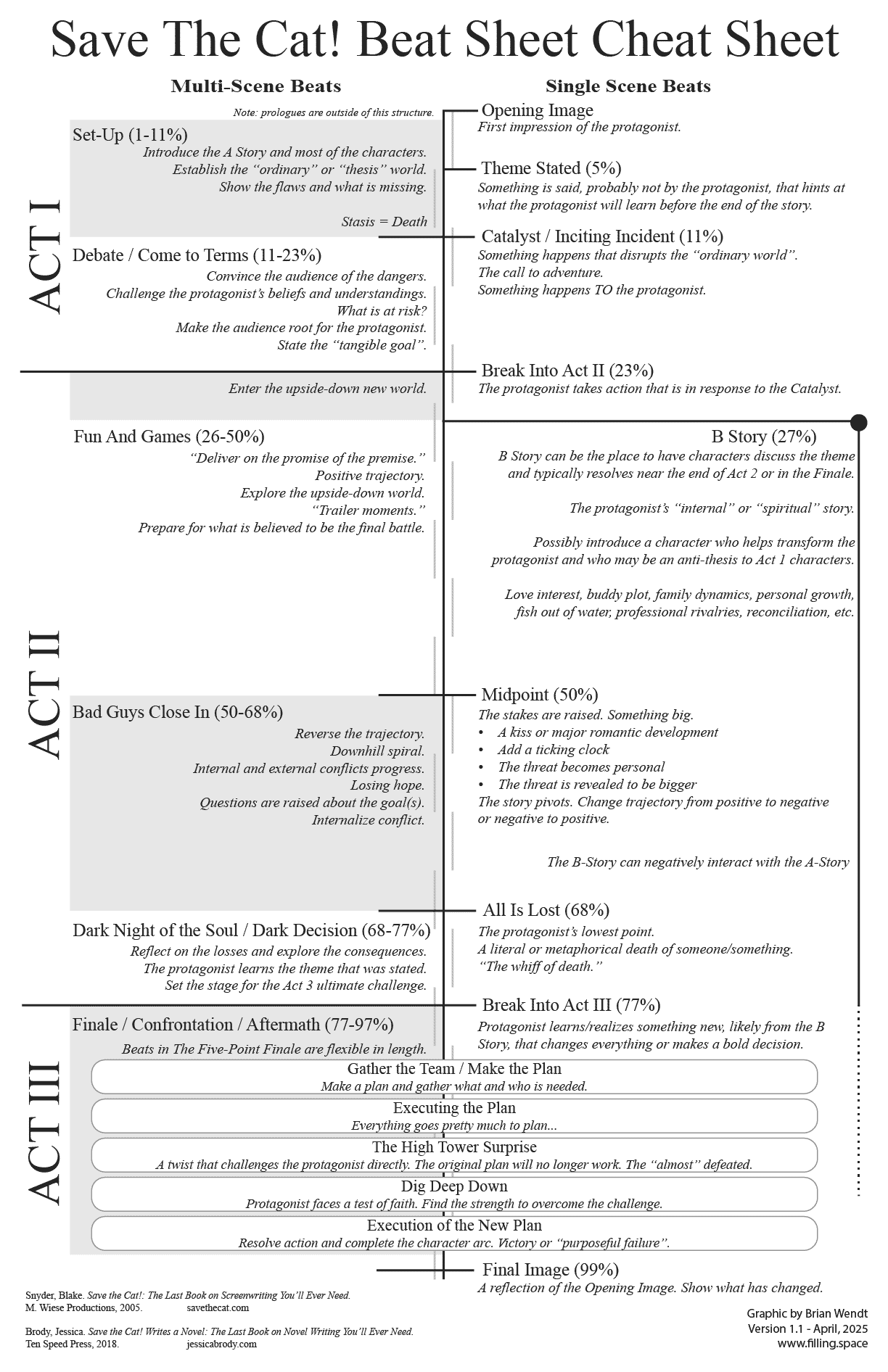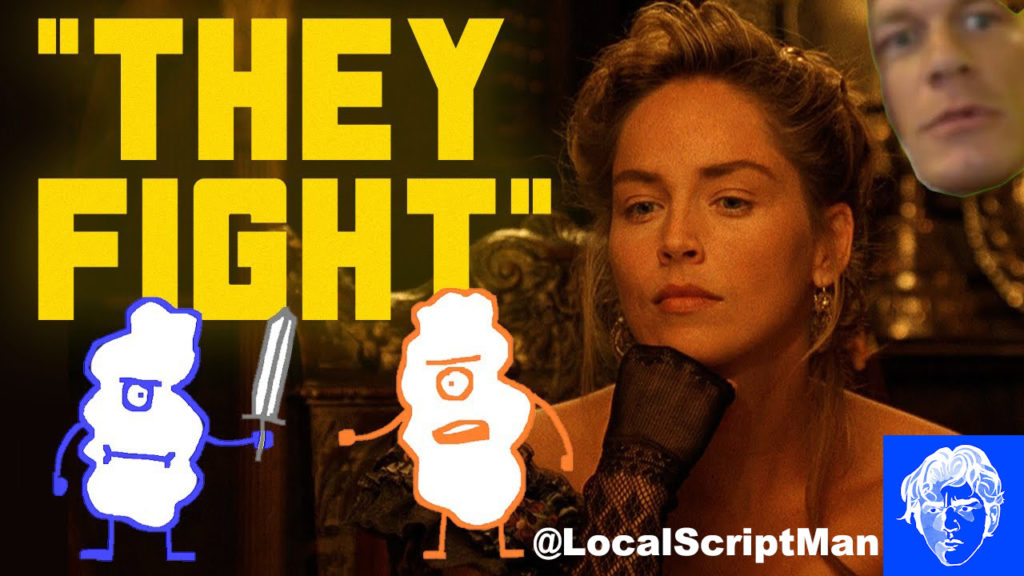Skip to the good bit: click here to download the PDF
In 2023, I finally checked out the book that seems to appear in every online conversation regarding the 3 Act Structure: Save The Cat! The Last Book on Screenwriting You’ll Ever Need by Blake Snyder. This book aims to reveal the hidden structure of Hollywood’s biggest hits. Snyder’s theory, as presented, is that there are 15 beats in 3 acts. The book breaks down a few popular movies, including some that Snyder personally worked on, to show that they hit the 15 beats in the timings he describes.
The “Opening Image”, “Midpoint”, and “Final Image” all happen exactly where you would expect them to be, some beats were less intuitive. Snyder says that the catalyst happens on page 12 of a screenplay and he gives some reasons. In reality, it is often plus or minus a few pages in blockbuster films.
I also found it difficult at first to understand what some of the beats really were. Like, what the heck is the Debate beat? Thankfully, Save the Cat! has a website (savethecat.com) that includes some articles diving deeper into the individual beats and also providing more beat sheets for popular films.
I also found that Save the Cat! Writes a Novel: The Last Book On Novel Writing You’ll Ever Need by Jessica Brody, a companion book to Snyder’s original book, was incredibly helpful. Brody clarified several points for me that even with multiple reads of Snyder’s book I still wasn’t clear on.
What I wanted was something I could print and put beside my desk for quick reference. I wanted it to not just be a list of the 15 beats, but a resource that would help troubleshoot my outlining. I first tried to fit it on a 8.5×11 sheet but that didn’t work out. 11×17 is not a size many home-office printers can handle, but any corner printing business can do it. My local FedEx does it for under $1 (black and white).
click here to download the PDF
I’ve included some tiny snippets from Blake and Brody plus some notes of my own.
The left side has beats that are described in page ranges or percentages. I personally think of them as sections. The right has the “this happens at this point” type beats and also notes on the B-Story. The short, light-gray bars down the center are 5% indicators.
I’ve also included a pseudo beat after Break into Act 2; enter the upside-down new world. This gets mentioned in the book but it’s sort of a short transition instead of a beat.
The 5 Point Finale is represented in a different visual way that I found helpful in distinguishing them from the 15 beats.
The Beats
You may already be familiar with the 15 beats, but here is a quick list including the Five-Step finale.
- Opening Image
- Theme Stated
- Set-Up
- Catalyst / Inciting Incident
- Debate
- Break into Act 2
- Enter the upside-down world
- B Story
- Fun and Games
- Midpoint
- Bad Guys Close In
- All is Lost
- Dark Night of the Soul
- Break into Act 3
- Finale
- Gather the Team / Make the Plan
- Executing the Plan
- The High Tower Surprise
- Dig Deep Down
- Execution of the New Plan
- Final Image
Personal Take Aways
I’ve already mentioned adding the pseudo beat after beat 6. I think it’s helpful to inform storytellers that this transition accounts for the gap between beats as defined in the book.
I’ve also made a note on the Cheat Sheet that prologues do not belong in the structure. The prologue goes in and out of favor and really depends greatly on genre and medium (film vs novel), but I think it’s important to note that if one is using a prologue, don’t let it screw up your beat sheet. Likewise, if you for some reason have an epilogue, it may run longer than the Final Image. I didn’t note this on the sheet because I don’t see epilogues often. From what I’ve seen, epilogues are more likely found at the end of a series and act as the Series’ Final Image. Oh, and if you didn’t know, you can kind of apply the beat sheet to a series. More on that in another post.
Open to Feedback
Did I get something wrong or could I improve the phasing? Yes, I’m sure. Maybe you have a tip or note to add that would help describe a beat even better. I’d love to hear from you.
The best place to reach me is in the Reddit community where there is a post dedicated to the Beat Sheet Cheat Sheet; I’ll check in on the discussion there from time to time.
Copyrights, Publication, and Disclaimer
Save The Cat! and the beat sheet are © Blake Snyder Enterprises.
The book, Save the Cat!: The Last Book on Screenwriting You’ll Ever Need, was published by M. Wiese Productions, 2005
Save the Cat! Writes a Novel: The Last Book On Novel Writing You’ll Ever Need was published by Ten Speed Press, 2018.
The Cheat Sheet is educational material meant to aid in learning the methods described in the two books I’ve mentioned. While the Cheat Sheet itself is copyrighted by Brian Wendt, it is free to non-commercially distribute fully intact. Do not remove the citations or the credit when distributing. What you do with your personal copy is up to you.
Small updates will get incremental version number increases.
Version 1.1 was published 2025-04-01
Version 1.0 was published 2024-04-29



